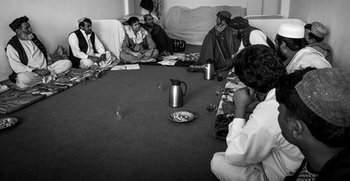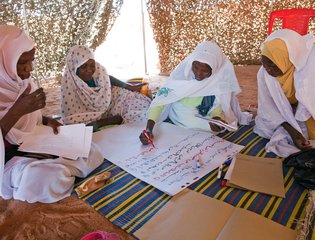Consulting people about the aid they receive is recognised as central to improving the quality of humanitarian assistance. This is particularly valuable in insecure contexts, such as Afghanistan and Somalia, where humanitarian staff have limited opportunities for face-to-face contact with the population. But are we communicating in an appropriate way, on the right issues, on a consistent basis and through the best channels? And what happens when aid agencies receive that information? These are the questions that the SAVE research project – a three-year study that seeks to improve aid delivery in volatile contexts – is trying to answer.
We consulted over 2700 people that had received aid in Somalia, Afghanistan, South Sudan and Syria. Only 400 of them said aid agencies had asked for their opinion.
That’s just 15 in 100, which left us wondering what aid agencies had to say about this. In Somalia we found humanitarians have developed a range of relatively sophisticated feedback systems, such as hotlines, SMS platforms and formalised office visits yet communities are often unaware of these or don’t know how to use them. Overall, the volume of feedback received was lower than agencies expected.
In Afghanistan, formal mechanisms are much less common. We found that most agencies collect feedback through phone or face-to-face conversations with local representatives or through local community monitors. In many cases, the information is not systematically used, and there is no clear division of responsibilities within agencies for addressing the issues raised by communities.
Surprisingly, despite the differences in practice between the two contexts – from Mogadishu and Dolow in Somalia to Kandahar and Helmand in Afghanistan – the views of the communities turned out to be remarkably similar. People were critical of existing feedback processes, and five common concerns emerged:
- Aid agencies rely too much on influential community representatives. Too often, agencies speak only with the local elders, gatekeepers, council members or government officials. As one woman in Mogadishu stated, “There is an obstacle between the [aid] organisations and the larger community because some of our leaders and committees are not fair and honest.”
- Communities almost never hear back from agencies after providing feedback. This confirms findings from other studies: collection of feedback alone is insufficient. A local council member from the Kandahar province told us, “We had a complaint about the rehabilitation projects in our village and told that to representatives from NGOs. They promised to not repeat it again in the future, but we have not seen any changes, and their activities have decreased since then.”
- Existing channels do not result in community members discussing sensitive matters. Especially in Somalia, aid agencies set up numerous phone hotlines. While useful for day-to-day complaints, these are inadequate to serve the originally intended purpose – finding out about corruption. In practice, almost none of the incoming calls concern such issues. Consulted communities explain that a certain level of trust is crucial before they feel comfortable enough to talk about delicate matters such as aid diversion and sexual abuse. For these discussions, they prefer regular face-to-face communication, preferably one-on-one.
- People are asked for feedback only at certain stages of aid projects. Communities are often consulted only when problems arise and after the programme has already been designed. Instead, they would like to be included from the outset, and regularly from then on. As an internally displaced man in Baidoa, Somalia, said, “It’s important to receive information about aid projects already before the NGO comes to our area for actual implementation.”
- Communities often do not know which organisation to issue complaints to. Except for certain well-informed community representatives, people are unaware of all the agencies operating in their area. They often do not know which agencies are responsible for the aid they received. Agency feedback mechanisms have led to confusion and frustration among affected people. One local elder from the Helmand province suggested that there should be a joint council, consisting of representatives from different aid agencies, that receives and addresses all complaints.
Common feedback mechanisms are rare and not easy to set up due to well-known challenges of incentivising aid agencies to coordinate and find common resources. But where these mechanisms do exist, such as in Nepal and Kenya, they suggest a commitment to collective accountability and transparency that communities are rightly demanding.
Similar mechanisms may be feasible in highly insecure settings as well. Overall, our research suggests that setting up functioning feedback systems in Somalia or Afghanistan does not require new or radically different approaches. But they do need thorough implementation of standard good practice and sufficient investments by aid agencies. Importantly, however, the stakes of getting this right are higher in insecure contexts: Where “drinking tea” and other casual encounters with affected communities become impossible, alternative feedback channels become ever more crucial.
To find out more about the potential for inter-agency approaches in insecure contexts, the SAVE research team is looking at the current usage of feedback mechanisms by Turkey-based humanitarian organisations providing aid in Syria. We are very interested in receiving your suggestions or questions about (joint) feedback mechanisms, so please reach out. Our final report, presenting the findings and good practice examples from Afghanistan, Somalia and Syria, will be available this spring through the SAVE webpage.


